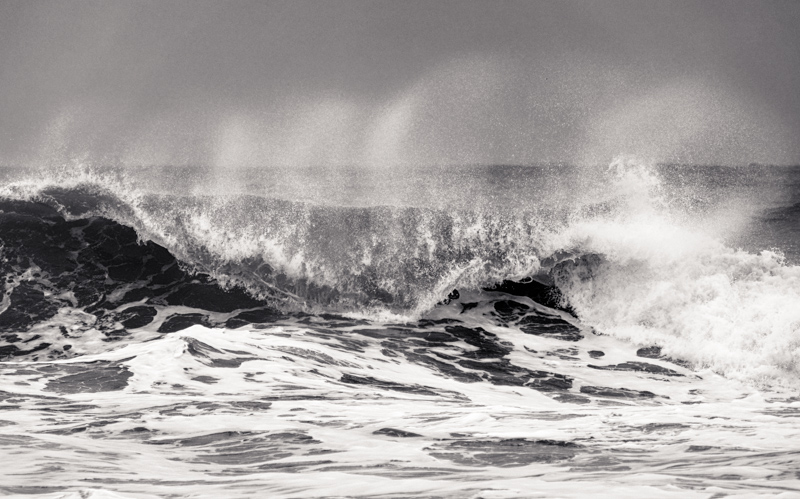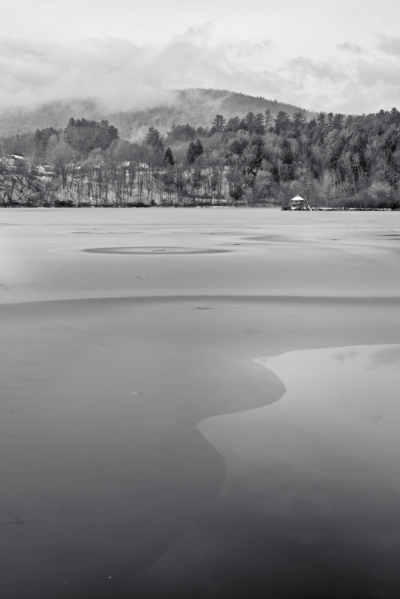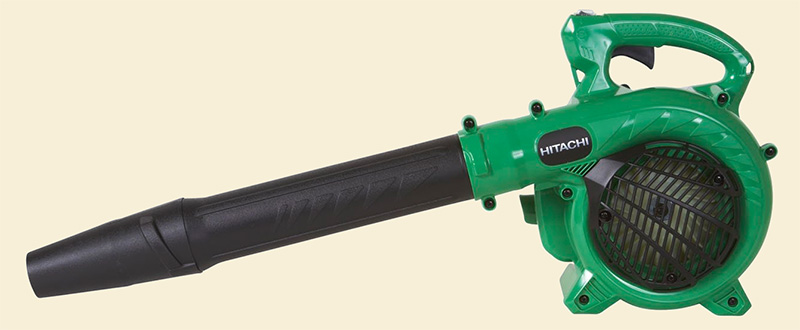Words and pictures by John Lehet
Recently TOP had some comments about the weatherproof qualities of Olympus pro gear. I can tell you that it's hard to exaggerate how good these cameras are at keeping the wet out. I think I might have subjected mine to the ultimate test.
Even though 90% of my exposures are made with a Sony full-frame body, I keep and carry an Olympus E-M5 Mark II. I use the Olympus for various reasons: it's easier to get greater depth of field with it when that's a consideration; the Olympus Pro zooms are the only zoom lenses I own; the IBIS is fantastic; and it's compact.
And it's extremely weatherproof. Though I've owned Olympus weather-sealed bodies for a few years now, my first real test came in the Summer of 2015, squatting on the edge of a pond one misty morning. I had been using the Olympus, and it was in my open bag. With the Sony to my eye, I heard a "plop."
It was not a frog.
The Olympus with ƒ/2.8 zoom attached had fallen into the pond, into a few inches of water. I quickly scooped it up and dried it off on my shirt as best I could.
It was fine.
Knowing that the camera had survived that, I felt confident using it on a beach in driving wind and a deluge the following Winter. The atmosphere and storm-whipped waves compelled me to photograph madly. I usually don't mind getting soaked, but I don't like to ruin camera gear. So I kept the Sony and its lenses back at the house we were staying in, and used the E-M5 Mark II with the 12–40mm ƒ/2.8 and the 40–150mm ƒ/2.8 Pro zooms. I got soaked to the bone. Of course, the camera and lenses were fine.
A shot taken with the E-M5 Mark II in wind and pouring rain
During this period, I had gradually developed the practice of carrying more gear than I had previously. The main problem with that was that the E-M5 Mark II body didn't always settle into its compartment in the bag anymore.
The day of the first big snow last year I did a lot of photography, in three sessions. I used the E-M5 Mark II and other cameras within walking distance in the first session. I drove someplace I thought might be good for a second session, and for the third session I was closer to home again.
Still snowing the next day, I went out again, and reached for the E-M5 Mark II in my bag. It wasn't there. I couldn't find it anywhere. Tracing my steps from yesterday I would only be slogging through eight to ten inches of new snow. If I was going to find the camera I would have to feel it with my foot. There would be a lot of ground to cover, kicking at acres of new snow cover. Hopeless.
So I wrote my little Olympus off as lost. Sometime later I replaced it with another used E-M5 Mark II body with low use, and I also replaced the 60mm ƒ/2.8 Macro lens lost with it.
First big snow day. Taken with the A7R II
Here in Vermont last Winter we had steady snow cover, but it was not by any means a Winter of powder. It rained as often as it snowed. Hard rain at times, including Winter thunderstorms. The snow has often been wet snow. While March was a Winter month, often below freezing, February was unusually warm, featuring a lot of thaws and rains. I've been painfully aware of this weather, knowing that I had an Olympus EM-5 Mark II with the 60mm ƒ/2.8 Macro lens out there somewhere. But then...
...Four and a half months later...
...I found the lost Olympus!
About two weeks ago, next to the path between the garden and house, there it was: lens-up, during Vermont's final mid-altitude snow melt. It had been out in the elements for four and a half months: four and a half months of hard, atypical, changing Vermont Winter. Raining and snowing, freezing and thawing. I grabbed it out of the snow and immediately took the lens off to look inside the camera and through the lens. There was some wet fog on an inner element, and condensation on the sensor glass. I took out the battery, which was dry. Camera and lens, separated, were placed in a sunbeam on a warm windowsill for a while, as I prepared a large glass jar with dry desiccant. The lens quickly cleared, and of course the sensor glass dried quickly.
The next day was maybe too soon to check, but I couldn't help my curiosity. I put the battery in, put the lens on, and powered it up.
It worked perfectly.
Well, not perfectly. There is still one little problem. The power switch does not power the camera off. Because I have never learned to use my left hand to turn that camera off (every other camera in the world has a power switch on the right side of the camera body), I've always been prone to keeping it on (by accident) and relying on it going to sleep within seconds of inactivity. That still works, so that's how I continue to use it.
For all practical purposes, the camera's function is the same as ever, even if the resale value isn't. I'm still keeping the camera and lens in a jar of desiccant in hopes that that last bit of water in the switch will dry. After this Summer's trip to Iceland I will probably sell the newer replacement body and newer lens for near what I paid, and keep the risk of failure here where it belongs.
The Olympus has risen: Honeybee and squill
Over the last few days I've used that lost-and-found camera and lens to make over a hundred exposures. All perfectly fine.
So if you know someone who's wondering whether Olympus means it when it says its cameras are "weatherproof," this Vermont photographer's answer is: oh, yeah.
John
John Lehet was our most recent print sale artist. Here is his website.
©2017 by John Lehet, all rights reserved
Original contents copyright 2017 by Michael C. Johnston and/or the bylined author. All Rights Reserved. Links in this post may be to our affiliates; sales through affiliate links may benefit this site.
Still works!
Give TOP a “Like” or Buy yourself something weatherproof
(To see all the comments, click on the "Comments" link below.)
Featured Comments from:
adamct: "I started reading this post pretty skeptical. I was expecting another story about holding a camera under running water or getting caught in a giant storm. I was wrong. That story is pretty amazing. I know how wet this winter was, and how great the temperature swings were.... Thanks!"
scott kirkpatrick: "Olympus has been careful about weatherproofing for a long time. Way back when the Olympus E-1 was new, there was a legendary example. A hard-working PJ had assembled a work kit of an E-1 and the basic lenses of that era, 11–22mm, 14–54mm, 50–200mm, and 50mm macro, and it all lived in a single capacious bag. Her faithful dog, feeling a bit neglected in favor of all this useful gear, decided to make it his own, marking the bag and all of its contents as only dogs can. It took about a week for the unusual smell to be tracked down to its source, but everything was soaked, rinsed clean—and continued to function flawlessly."
John: "I think my Olympus just surpassed my 1DX in the trust I put in it. Thanks!"
DB: "Notes to self: a.) replace long-serving E-M5 with E-M5 II when convenient; b.) don't lend John Lehet any photographic equipment."
John Lehet replies: Unfortunately this is far truer than you know. Though I had a multi-decade stretch of zero disasters, recent months have been off the chart. Since mid October I've had some crazy losses. I also lost a Zeiss Loxia 50 somehow—tumbled out of bag. And in late December I had a very expensive Zeiss Loxia 21mm pickpocketed out of my bag at night in the crowded city park where I took this picture.
On one outing this winter, I fell into this river, but only knee deep. I managed to fall onto the bank as I fell through what I thought was solid ice, but which was only a crust made of ice crystals.
I managed to fall onto the bank and not into the river.
Then another outing, I slid down the bank on my back along the side of a frozen waterfall. It turned out the soil was basically ice, and almost as slippery as the fall itself. I had just lost one of my ice cleats from one boot. The debris on the ice at the bottom of the fall is all stuff that came sliding down with me. I was very lucky to have managed to stop there, since it dropped off even more steeply just below.
In that case my Mindshift Rotation Pro backpack protected my gear perfectly, even though I ripped a coat and some jeans in the slide.
The bigger and tougher pack instead of carrying two bags, as I had been, I think is going to help a lot.
I think the cause of my disasters is largely that I am so heavily using so much gear. My gear isn't as simple as it used to be, and lately my use is exponentially greater. Also, in the fall my father died, and I think the grief was a kind of disability in terms of functioning normally.
Someone joked about a GPS. In fact after these mishaps, my adult children, wonderful people, got me for Christmas a Gear Eye from Kickstarter. It hasn't shipped yet, but I think it is due soon.
Colin Work: "I can't give any objective measures, but as a sailing photographer, I've written off a number of allegedly weather-sealed Canon items due to rough conditions at sea. I decided to give Olympus a try and in some three years of year-round sailing in sometimes horrible conditions, I've not had a water related issue."






